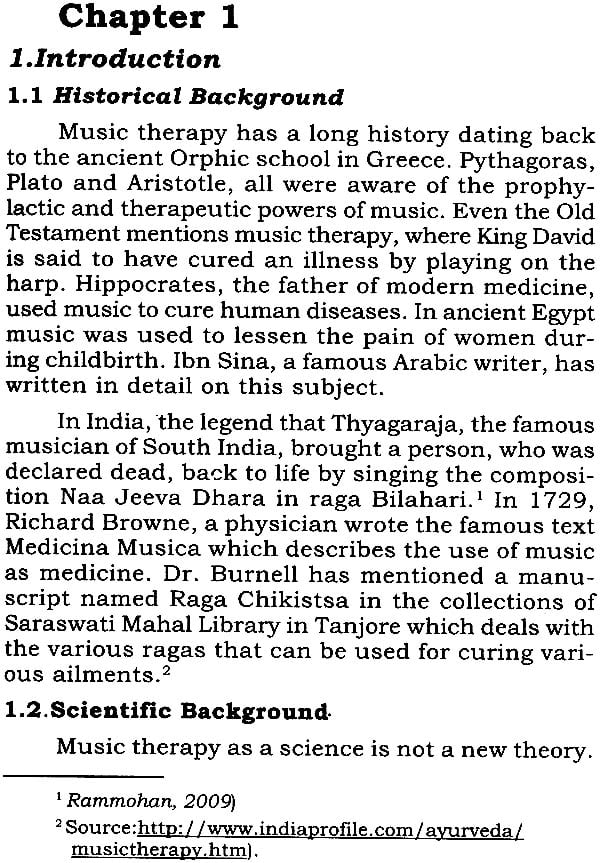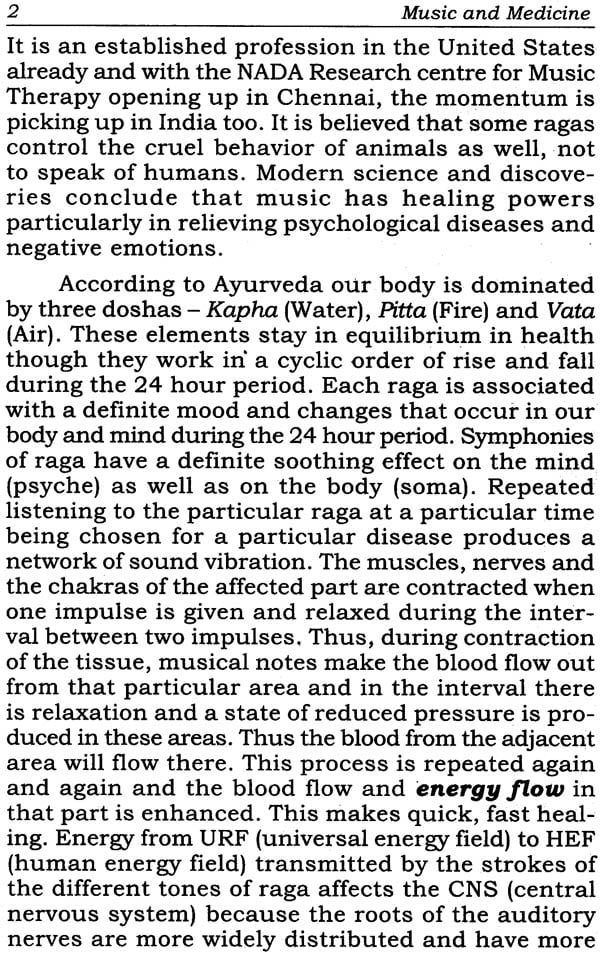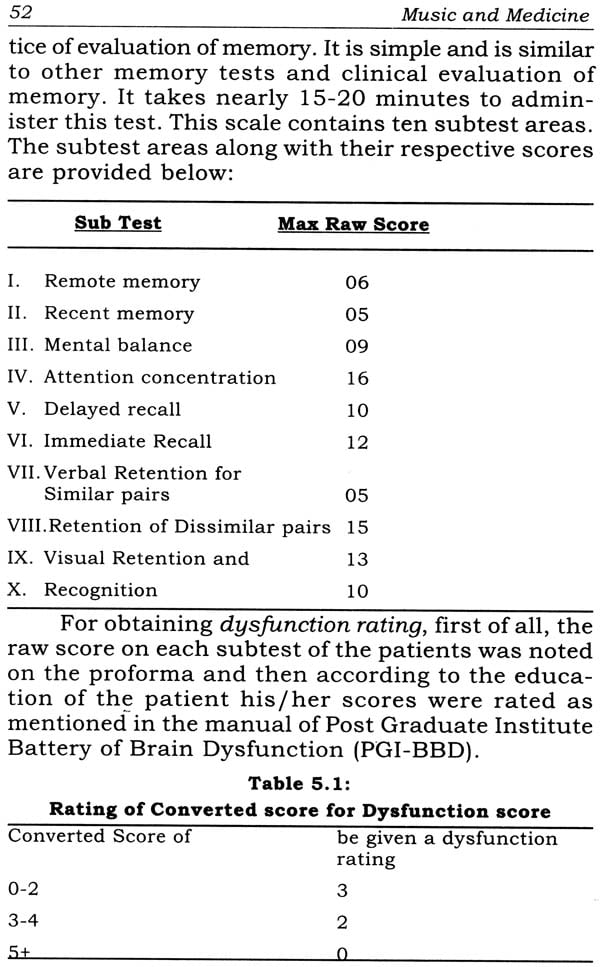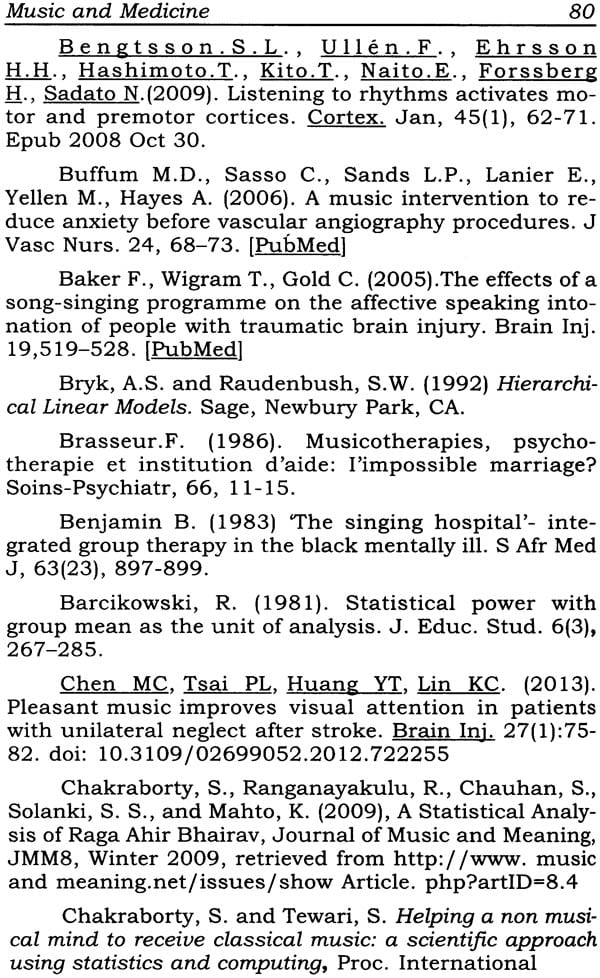
Music and Medicine (Healing Brain Injury Through Ragas - A Study)
Book Specification
| Item Code: | NAM238 |
| Author: | Shashi Bhushan Singh |
| Publisher: | CBH Publications |
| Language: | English |
| Edition: | 2016 |
| ISBN: | 9789383811298 |
| Pages: | 113 |
| Cover: | Paperback |
| Other Details | 9.0 inch X 6.0 inch |
| Weight | 130 gm |
Book Description
While music and medicine and music therapy are now widely practised in the hospitals in the western countries, India is very much lagging behind in such pursuits, despite the rich tradition of ragas in Indian Classical music.
Encouraged by the successful implementation and researches on western music as a therapeutic tool in the developed countries, this study was undertaken bashed on Hindustani ragas on Indian Patients.
The implications of the present findings will definitely encourage other professional statisticians and medical community to come forward and collaborate with doctors areas of medicine and promoting and establishing music and music therapy as a profession in India.
Last but not the least, music-especially classical music- has the power to improve one’s conscience and hence can help us in becoming a better human being.
Shashi Bhushan Singh, MSc (Statistics), PhD. in Science, is currently working as lecturer cum statistician in the Department of Preventive and Social Medicine, Rajendra Institute of Medical Sciences (RIMS), Ranchi, India. His contribution in this book includes both interaction with the patients and statistical analysis in the study.
Soubhik Chakraborty, M.Sc.(Statistics), PhD in Science (Statistics), is a professor in the Department of Mathematics, Birla Institute of Technology, Mesra, Ranchi, India. He is also a harmonium player. His contributions to the book include providing expert statistical opinion and views on issues related to music as well as review and designing of the book.
There was a time when deaths were caused mostly by infectious diseases like malaria, small pox, TB, plague etc. Thanks to the advances in medical sciences, we have overcome most of these maladies. The deaths which currently take place are caused mainly by heart attacks, diabetes, cancer, hypertension etc. or in other words diseases that have more to do with our modern lifestyle. This is a very strong point that goes in favour of music and medicine and music therapy. While music and medicine and music therapy are now widely practiced in the hospitals in the western countries, India is very much lagging behind in such pursuits, despite the rich tradition of ragas in Indian classical music. The Medical Council of India is yet to recognize music therapy as a branch of modern medicine, necessitating all the more effort and perseverance for a scientific study in music in the Indian context.
Encouraged by the successful implementation and research on western music as a therapeutic tool in the developed countries, we were motivated to undertake a similar study in Hindustani ragas on Indian patients. However, as "Indian patients" is too broad a term. The present work focuses only on the patients with cerebrovascular accident (CVA) and diffuse head injury (DHI) admitted to Rajendra Institute of Medical Sciences (RIMS), Ranchi, the capital of Jharkhand state in India. This is a collaborative effort between RIMS hospital and Birla Institute of technology, Mesra, Ranchi, India. Exploring areas other than head injury is reserved as a rewarding future work.
As is done in such clinical studies, the patients were divided into two groups. One group, called the controlled group received only medicine but no music while the other group, the case group, consisted of patients who received both medicine and music. The allocation of the patients to these two groups was done randomly, using a statistical technique called randomized control trial (RCT). The objective was to establish statistically whether the case group pa- tients recover significantly faster, which they did, thereby endorsing the therapeutic value of the ragas. We hope that the implications of the present findings will definitely encourage other professional statisticians to come forward and collaborate with the doctors in promoting and establishing music medicine and music therapy as a profession in India and other developing countries.
Last but not the least, music - especially classical music - has the power to improve one's conscience and hence can help us in becoming a better human being. With a sudden increase in crimes of various forms in the recent years, we strongly feel that listening to melodious music, which is soothing to the sympathetic nervous system, be made compulsory for everyone. We wholeheartedly support Prof. Michael Thaut's advice to all to involve music as a part of their life and in learning to play at least one musical instrument (Thaut, M. H., Rhythm, Music and the Brain, Taylor and Francis, N.Y., 2005). The educational authorities should seriously think of making music a compulsory subject at least as non credit course in all the educational institutions in the developing countries.
We thank the Director of RIMS, Ranchi, the Vice- Chancellor of Birla Institute of Technology, Mesra, Ranchi, the patients and their relatives without whose consent this study would not be possible. All the authors are thankful to their respective family members, colleagues and friends for their encouragement and support. In particular, the second author thanks his wife Purnima, D.Mus. (BHU, Varanasi) and her guru Dr. (Ms) Vanamala Parvatkar, renowned vocalist of the Banaras Gharana and formerly Head (vocal), Faculty of Performing Arts, BHU, Varanasi for the musical discussions. He is indebted to his doctor uncle Dr. Basudeva Misra, M.S., retired Sr. Surgeon, HEC Plant hospital, Ranchi, for several medical advices and fruitful discussions related to the study. We would also like to thank Sri Joyon Majumdar who is a student of the Vivekananda Vidya Mandir, Ranchi, for the excellent painting of the Hindustani concert done for the cover art.
During the research project the audio renderings of famous songs were presented to the patients at different levels rendered by famous musicians and stalwarts. But due to copyright reasons, they could not be presented alongwith the book. However we were able to get the singers who were very happy to render the same songs in audio form and we were fortunate enough to record them at nearby studios. The strain and stress of these artists in rendering these songs are to be very much appreciated. As a token of our appreciation, we decided to give an audio cd of the renderings alongwith the book. We received the help of Mr.Easwaran in re-editing these audio renderings and he was instrumental in preparing and presenting these cds. A list of these artists and the songs are given after the glossary at the end of the book. The audio cd is available alongwith the book.
We are going ahead with further studies on diseases which are becoming more relevant these days like diabetes, cancer, etc., and we hope to present these studies in its entirety later.
We are thankful to Sri.M.Easwaran, Editor, CBH Publications, who under took the editing and designing the book in its present form. He agreed to publishing this study realising the importance of this study in paving the way for further research in Music-medicine and music therapy. We are also thankful to Smt.M.Girija, the Publisher for undertaking the publishing of this book.
| Preface | ||
| Chapter 1: | Introduction | 1-18 |
| 1.1, | Historical Background | |
| 1.2, | Scientific Background | |
| 1.3, | Literature review | |
| Chapter 2: | A Critical Comparison between Indian and Western music | 19-26 |
| Chapter 3: | Impact of music on brain: A scientific overview | 27-34 |
| 3.1 | Brain Structure | |
| 3.2 | Brain's embryology | |
| 3.3 | Major subdivisions of brain | |
| 3.4 | Language area in the brain | |
| 3.5 | Lateralization & dominance of cortical functioning | |
| 3.6 | Are we born musical? | |
| 3.7 | Link between Genetics and Music | |
| 3.8 | Central and Peripheral Pathways | |
| 3.8.1 | Dopaminergicpathways in Brain | |
| Chapter 4: | Impact of Hindustani Ragas on the Level of Mood Depression in Patients with Cerebrovascular Accident and Diffuse Head Injury. | 35-50 |
| 4.1 | Chapter introduction | |
| 4.2 | Materials and Methods | |
| 4.3 | Experimental results | |
| 4.4 | Discussion | |
| 4.5 | Chapter conclusion | |
| Chapter 5: | Impact of Hindustani Ragas on Verbal and Non-verbal memories of Patients with Cerebrovascular Accident and Diffuse Head Injury | 51-58 |
| 5.1 | Chapter introduction | |
| 5.2 | Experimental results | |
| 5.3 | Discussion | |
| 5.4 | Chapter conclusion | |
| Chapter 6: | Training nonmusical patients to receive the medicinal benefits of ragas: A statistical approach | 59-66 |
| 6.1 | Chapter introduction | |
| 6.2 | Methodology | |
| 6.3 | Experimental results | |
| 6.4 | Chapter conclusion | |
| Chapter 7: | Concluding remarks | 67-68 |
| Appendices | 69-76 | |
| Bibliography | 77-88 | |
| Glossary | 89-95 | |
| List of singers and songs presented in the audio cd | 96 |













